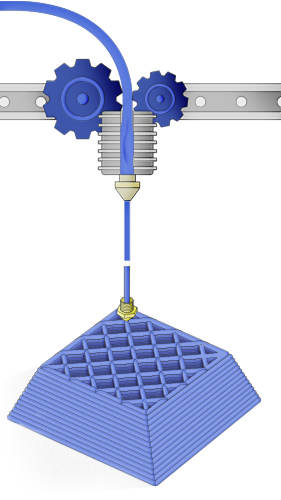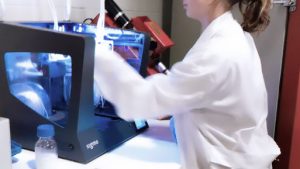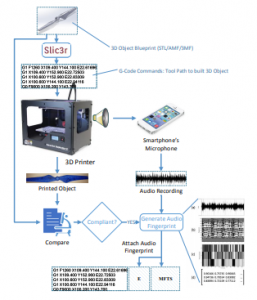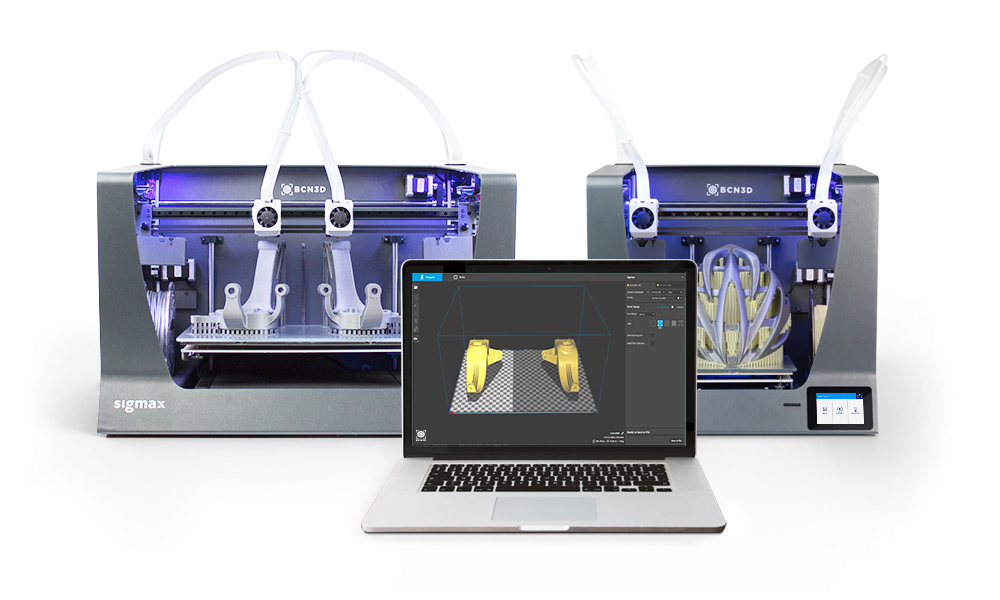WATCH: BCN3D’s vast 3D printing farm
BCN3D Spins Off into Standalone Company After Receiving $3 Million in Seed Funding
 BCN3D put Barcelona on the map for 3D printing years ago. They have continued to be one of the main players in desktop offerings too, with IDEX 3D printing technology, and the initial offering of their Sigma, an FFF 3D printer allowing for dual color and multi-material production, along with a host of other features, and other hardware that has been added to their 3D printer lineup too.
BCN3D put Barcelona on the map for 3D printing years ago. They have continued to be one of the main players in desktop offerings too, with IDEX 3D printing technology, and the initial offering of their Sigma, an FFF 3D printer allowing for dual color and multi-material production, along with a host of other features, and other hardware that has been added to their 3D printer lineup too.
Continually growing (and sharing) in technical development, they also released the open source CAD files for their powerful Sigmax 3D printer last year. Now, they are an independent company, after raising $3 million in funding in a recent seed round with VC firms Accurafy4, JME VC and Victoria.
“We are really excited to join BCN3D’s adventure in this impressive sector that has already started changing the world. The limits of Additive Manufacturing and Digital Manufacturing are still to be discovered and its potential is massive,” said Samuel Gil, Partner at JME Venture Capital. “We believed BCN3D will play a major role in this revolution since the moment we met the team. Their talent, passion, and execution skills are exceptional. They have a unique vision of the industry and their ambition to lead the market is as promising as the products they are developing.”
 Notably, BCN3D emerged from Spain’s Universitat Politècnica de Catalunya (UPC) as a program and spin-off from their technological center, CIM UPC—with Roger Uceda as CEO and then a company transition as Xavier M. Faneca took his place. Taking off as a standalone, the new BCN3D has been founded by the following members: Martinez Faneca (CEO), and the executive team including Roger Antunez, Pol Domenech, Marc Felis, Jose Antonio Ortega, Eric Pallares, and technology advisor, Roger Uceda.
Notably, BCN3D emerged from Spain’s Universitat Politècnica de Catalunya (UPC) as a program and spin-off from their technological center, CIM UPC—with Roger Uceda as CEO and then a company transition as Xavier M. Faneca took his place. Taking off as a standalone, the new BCN3D has been founded by the following members: Martinez Faneca (CEO), and the executive team including Roger Antunez, Pol Domenech, Marc Felis, Jose Antonio Ortega, Eric Pallares, and technology advisor, Roger Uceda.
“Technology transfer is, along with research and training, our greatest commitment related to the challenges of Industry 4.0 and Additive Manufacturing,” said Francesc Torres, Rector at Universitat Politècnica de Catalunya – BarcelonaTech (UPC). “The project of BCN3D has been developed within our technological center CIM-UPC and it’s an example of how knowledge can generate value and have a social impact. We are very proud of this new step for BCN3D and we will support their growth from the university.”
Throughout the years, BCN3D has introduced multiple refinements and additions to their hardware series, as well as new materials. Continuing to lead with IDEX technology, known to double productivity in desktop 3D printing, they have recently sold over 5,000 3D printers through their global network of 60 distribution partners.
“BCN3D is one of the largest spin-offs from an engineering university we have seen in Spain and one of the largest in Europe. They have a breakthrough technology—IDEX—that only the best spin-offs have, plus a degree of commercial traction that most spin-offs need years to accomplish and that they’ve already got before day one,” said Abel Conill, General Partner at VICTORIA Venture Capital. “We are thrilled to be part of the company and are fully committed to helping the team accomplish their future goals.”
BCN3D 3D printers are used for industrial purposes such as:
- Prototyping
- Functional validation
- Manufacturing of tooling, jigs, fixtures
“Since BCN3D introduced the IDEX technology I knew they would become one of the big players in the Additive Manufacturing industry. We have high expectations on the company’s commercial growth and their ability to create market dominance through new technology development,” said François Minec, Accurafy4’s Lead Investor. “At Accurafy4 we are now delighted to join the company and we will make our best efforts to maximize BCN3D’s global impact and develop strategic partnerships.”
Current and past BCN3D clients include industry leaders such as BMW, Samsung, Louis Vuitton, Nissan, NASA, HTC, and SEAT—or ALBA Synchrotron.
“We are working on a new range of products to improve the experience of our clients and take the IDEX to a completely new level,” says Faneca, regarding current BCN3D innovation initiatives.
“With this funding, we will be able to ramp-up our production to meet the market demand and cut down the long delivery periods we have experienced in the past due to production limitations.”
What do you think of this news? Let us know your thoughts! Join the discussion of this and other 3D printing topics at 3DPrintBoard.com.
[Source / Images: BCN3D]
Desktop 3D printed PLA proven to help researchers in pursuit of cancer cure
Researchers Use 3D Printing to Isolate Aggressive Breast Cancer Cells
Researchers at the University of Girona have successfully isolated stem cells from one of the most aggressive forms of breast cancer – using 3D printing. The goal of isolating the cells is to find a drug that attacks them exclusively, without damaging healthy parts of the body.
 According to Dr. Teresa Puig, Director of the Oncology Unit of the Group for the Investigation of New Therapeutic Targets, these breast cancer cells still remain in the body after treatment via chemotherapy or radiotherapy and often cause relapse. This particular type of cancer is the triple negative subtype, which occurs in young women and leads to relapses in 20 to 30 percent of patients within three or four years.
According to Dr. Teresa Puig, Director of the Oncology Unit of the Group for the Investigation of New Therapeutic Targets, these breast cancer cells still remain in the body after treatment via chemotherapy or radiotherapy and often cause relapse. This particular type of cancer is the triple negative subtype, which occurs in young women and leads to relapses in 20 to 30 percent of patients within three or four years.
“A tumor is made up of many types of cells, and these are the cells we have in low proportions,” said Dr. Puig. “Therefore, it is complicated to locate these cells within the tumor. This new system is cleaner, allowing us to work more directly with these types of cells later.”
The research is documented in a paper entitled “Screening of Additive Manufactured Scaffolds Designs for Triple Negative Breast Cancer 3D Cell
Culture and Stem-Like Expansion.” The main goal of the study was to develop a scaffold architecture that afforded a high breast cancer cell proliferation rate. Several values of the selected parameters, which included layer height, infill density, infill pattern, infill direction, and flow, were tested on the slicing software BCN3D Cura and the scaffolds were 3D printed on the BCN3D Sigma 3D printer.
Using the Taguchi experimental design method, 27 scaffold configurations were manufactured and analyzed. At least 10 copies of each configuration were 3D printed to perform the characterization and cell proliferation assays, with the objective being to see which geometric form was most effective in separating the stem cells.
“This structure is a mesh that, on the basis of a series of parameters such as porosities, spaces, and the distance between one element and another, is ultimately able to allow cells to stick to the matrix or not, to grow, and to be able to ‘enrich themselves’, as our colleagues say,” said Joaquim de Ciurana, Director of the Research Group on the Engineering of Products, Processes, and Production.
Before this research, these cell cultures were produced two-dimensionally, which did not allow the cells to be effectively separated, so specific drugs could not be produced to attack the cells. But the 3D method in which the researchers isolated the stem cells for this study allows them to better study the cells in order to find the bio-indicators responsible for the tumors. They will then be able to attack them with pharmaceuticals, although the research is not yet at that point.
“We still do not know how to treat them, but we have found a way to isolate them,” said Dr. Puig.

Optical microscope images of cells attached to different scaffolds configurations. White arrows indicate cells adhered to PLA filament.
This method is also more cost-effective than traditional analysis methods, allowing for more frequent experiments in the future.
Authors of the paper include Emma Polonio-Alcalá, Marc Rabionet, Antonio J. Guerra, Marc Yeste, Joaquim de Ciurana and Teresa Puig. Several of these scientists were also involved in a recent study about 3D printed composite stents.
Discuss this and other 3D printing topics at 3DPrintBoard.com or share your thoughts below.
[Source/Images: BCN3D Technologies]
3D printing news Sliced Additive Industries, PyroGenesis, axial3D, Rocket Lab
Using Audio to Verify the Integrity of 3D Printed Objects
 3D printing carries with it a host of security concerns. Tampering with a 3D printed object can happen remotely if someone hacks into the 3D printer while online, and no one may ever be any the wiser – until the component fails. It can be hard to verify the integrity of a 3D printed object by sight, so it takes some creativity to be able to determine that a part has not been tampered with. In a newly published paper, a group of researchers detail their method of verifying a 3D printing object’s integrity – via audio signature.
3D printing carries with it a host of security concerns. Tampering with a 3D printed object can happen remotely if someone hacks into the 3D printer while online, and no one may ever be any the wiser – until the component fails. It can be hard to verify the integrity of a 3D printed object by sight, so it takes some creativity to be able to determine that a part has not been tampered with. In a newly published paper, a group of researchers detail their method of verifying a 3D printing object’s integrity – via audio signature.
The paper, entitled “Digital Audio Signature for 3D Printing Integrity,” can be accessed here. In it, the researchers describe their tactic, which involves the acoustic side-channel emanations generated by the 3D printer’s stepper motors. Two algorithms are used to create a verification system. The first is used to generate a master “audio fingerprint” for the unaltered 3D printing process. The second is applied when the same object is 3D printed again, and it compares the audio produced during the printing process to the master fingerprint.
To evaluate the quality of the proposed thresholds, we identify the detectability thresholds for the following minimal tampering primitives: insertion, deletion, replacement, and modification of a single tool path command,” the researchers explain. “By detecting the deviation at the time of occurrence, we can stop the printing process for compromised objects, thus saving time and preventing material waste.”
 The researchers who completed this study are the same who deliberately sabotaged a 3D printed drone during the printing process in order to demonstrate how disastrous such tampering can be – and how easy it is to do, and difficult to detect. A phishing attack downloaded and replaced the files for a 3D printed replacement rotor blade, adding hollow cavities inside it that were invisible once 3D printed. The team 3D printed and attached the blade to a drone, which they then flew. Once the drone reached a certain height, the blade broke off, crashing the whole thing.
The researchers who completed this study are the same who deliberately sabotaged a 3D printed drone during the printing process in order to demonstrate how disastrous such tampering can be – and how easy it is to do, and difficult to detect. A phishing attack downloaded and replaced the files for a 3D printed replacement rotor blade, adding hollow cavities inside it that were invisible once 3D printed. The team 3D printed and attached the blade to a drone, which they then flew. Once the drone reached a certain height, the blade broke off, crashing the whole thing.
“Although this sabotage only led to the loss of a $1000 drone, similar attacks on functional parts for safety-critical systems may cause tremendous monetary losses, disruptions, and loss of human life,” the researchers point out.
The new study doesn’t use any specialized equipment, instead relying on a smartphone to record the sounds produced by the 3D print in process. The verification algorithm is implemented as a cloud-based app. The method can detect deviations of individual gcode commands, alerting users to even the smallest alteration in the design file.
The paper goes on to describe how the researchers tested their method several times, using a BCN3D Sigma 3D printer. There were a few challenges to the process, such as channel mismatch, which involved the recordings being mismatched thanks to other reasons than sabotage. These included background noise, different recording positions, different recording devices, and elapsed time from the recording of the master file. With careful attention, these issues can be overcome, and the researchers explain that the algorithm is designed to overcome a certain amount of background noise.
It’s incredible that smartphones are capable of such high-quality recording, which has a negative side as well – other scientists have pointed out that it’s possible for hackers to record the sounds a 3D printer makes while printing and then use those sounds to reverse engineer and reproduce an item. It’s a constant battle between hackers and those trying to prevent hacking, with each side armed with increasingly sophisticated tools. This latest study demonstrates an excellent way to verify the integrity of a 3D printed object, however, ensuring that critical components won’t be compromised.
Authors of the paper include Sofia Belikovetsky, Yosef Solewicz, Mark Yampolskiy, Jinghui Toh, and Yuval Elovici.
Discuss this and other 3D printing topics at 3DPrintBoard.com or share your thoughts below.




